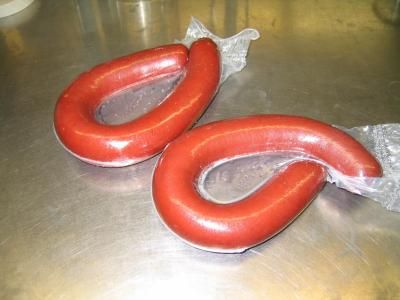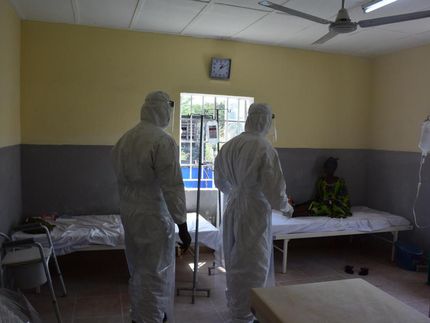Antimicrobial edible films inhibit pathogens in meat
Antimicrobial agents incorporated into edible films applied to foods to seal in flavor, freshness and color can improve the microbiological safety of meats, according to researchers in Penn State's College of Agricultural Sciences.

This image shows ring baloney wrapped in edible, antimicrobial fllm.
Penn State College of Agricultural Sciences
Using films made of pullulan -- an edible, mostly tasteless, transparent polymer produced by the fungus Aureobasidium pulluns -- researchers evaluated the effectiveness of films containing essential oils derived from rosemary, oregano and nanoparticles against foodborne pathogens associated with meat and poultry.
The results demonstrate that the bacterial pathogens were inhibited significantly by the use of the antimicrobial films, said Catherine Cutter, professor of food science. She hopes that the research will lead to the application of edible, antimicrobial films to meat and poultry, either before packaging or, more likely, as part of the packaging process.
In the study, which was published online in the April issue of the Journal of Food Science, researchers determined survivability of bacterial pathogens after treatment with 2 percent oregano essential oil, 2 percent rosemary essential oil, zinc oxide nanoparticles or silver nanoparticles.
The compounds then were incorporated into edible films made from pullulan, and the researchers determined the antimicrobial activity of these films against bacterial pathogens inoculated onto petri dishes.
Finally, the researchers experimentally inoculated fresh and ready-to-eat meat and poultry products with bacterial pathogens, treated them with the pullulan films containing the essential oils and nanoparticles, vacuum packaged, and then evaluated for bacterial growth following refrigerated storage for up to three weeks.
"The results from this study demonstrated that edible films made from pullulan and incorporated with essential oils or nanoparticles have the potential to improve the safety of refrigerated, fresh or further-processed meat and poultry products," said Cutter. "The research shows that we can apply these food-grade films and have them do double duty -- releasing antimicrobials and imparting characteristics to protect and improve food we eat."
Working in Cutter's laboratory in the Department of Food Science, Mohamed Morsy, a doctoral student at Benha University in Egypt, conducted the research. Morsy was at Penn State as a Borlaug Fellow through a grant provided by the USDA-Foreign Agricultural Service.
The edible films are a novel but effective way to deliver antimicrobial agents to meats, Cutter explained, because the bacteria-killing action is longer lasting. Liquid applications run off the surface, are not absorbed and are less effective. The pullulan films adhere to the meat, allowing the incorporated antimicrobials to slowly dissolve, providing immediate and sustained kill of bacteria. In addition, the microorganisms do not have the opportunity to regrow.
Cutter conceded that pullulan films are not as oxygen-impermeable as plastic packaging now used to package meats, so the edible films are not likely to replace that material.
"The meat industry likes the properties of the polyethylene vacuum packaging materials that they are using now," she said. "However, the one thing I really want to be able to do in the next few years is to figure out a way to co-extrude antimicrobial, edible films with the polyethylene so we have the true oxygen barrier properties of the plastic with the antimicrobial properties of the edible film."
Knowing that edible films can release antimicrobials slowly over time and keep bacteria in meat at bay, further research will be aimed at creating what Cutter referred to as "active packaging" -- polyethylene film with antimicrobial properties.
"Right now, we have two different packaging materials that are not necessarily compatible, leading to a two-step process. I keep thinking there's a way to extrude edible, antimicrobial film in one layer with polyethylene, creating all-in-one packaging.
"The chemistry of binding the two together is the challenge, but we need to find a way to do it because marrying the two materials together in packaging would make foods -- especially meat and poultry -- safer to eat."
























































